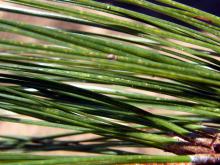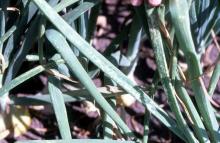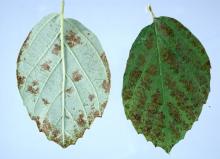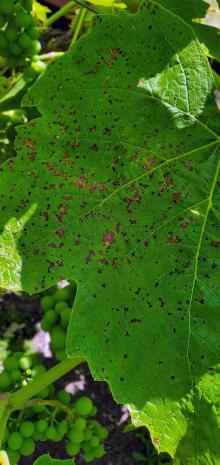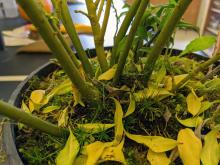There is great interest in air quality all over the Western United States when smoke from forest fires fills valleys during the
summer. Most of the smoke problem is due to small particulates, which are not known to damage plants with minor exceptions (see below). Ozone, however, is known to damage plants. Ozone in the upper atmosphere protects us from damaging sunlight. It can also be used to sanitize irrigation water. But at certain concentrations for certain periods of time it can injure sensitive plants.
Ground-level ozone is called smog. Smog-forming pollutants are primarily generated by internal combustion engines and not smoke from forest fires. Traffic and activities in urban areas generate the most pollutants, but often the wind blows the pollution to outlying suburban and rural communities. Emissions of hydrocarbons and oxides of nitrogen in the morning combined with summer heat and intense sunlight in the afternoon to produce ground level ozone – smog.
Smog is a problem for the Portland-Vancouver and Medford, Oregon metropolitan areas during the summer months. It is created most often on days when the temperature is 90°F or higher, especially when winds are light or non-existent.
All areas of Oregon currently meet the federal air quality standard for ozone. These levels, however, are based on human health. Sensitive plants can have problems when the ozone concentration is between 50–120 parts per billion (ppb)—120 ppb equals 12 pphm (parts per hundred million)—for extended time periods. The Eugene ozone monitoring station recorded at least 7 days during the summer of 2017 that met this requirement.
Ozone levels in the Puget Sound basin have exceeded the National Ambient Air Quality Standard (NAAQS) on several occasions last century. Sensitive plants grown near Seattle and Tacoma (Washington), Portland (Oregon), Vancouver (British Columbia), or any growing metropolitan area, are at risk.
What are the most sensitive plants? The list is long but includes alder, begonia, blackberry, currant, dahlia, fuchsia, grape, lilac, milkweed, ninebark, Oregon ash, Oregon oak, petunia, poplar (including aspen), radish, sequoia, snowberry, sycamore, tomato, and tulip poplar. There can be wide differences in tolerance within a group or species where certain cultivars are more sensitive than others.
Ozone symptoms on plants usually occur between the veins on the upper leaf surface of older and middle-aged leaves but may also involve both leaf surfaces for some species. The cells of the palisade parenchyma of the most recently expanded leaves are the most sensitive to ozone injury. Tissue along the major veins usually remains unaffected. For narrow leaved plants, conifers and broad-leaved plants in which the mesophyll is not differentiated, cells near the stomata are primarily attacked resulting in symptoms on all leaf surfaces.
For dicots exposed to high concentrations, symptoms may include bleaching, flecking, stippling, and interveinal necrosis. Less severe symptoms can include bronzing, chlorosis, and premature senescence of various plant parts. Monocots may show chlorotic or white-to-tan necrotic lesions or necrosis of the margin and/or tip of the leaf blade. Less severe symptoms can also include chlorosis and premature senescence. Severe conifer symptoms include needle banding where clear bands of chlorotic tissue develop and needle tipburn. Less severe conifer symptoms include flecking of older needles, mottling of younger needles and premature needlecast.
In grapes, it is referred to as “oxidant stipple” or “ozone stipple” and has been observed in Oregon. Symptoms of ozone damage appear predominantly on older grape leaves. Small interveinal spots (0.1mm to 0.5 mm in diameter), occur only on the upper leaf surface. The lower-leaf surface does not show stipple symptoms but may show necrotic spots if symptoms are severe. Stipple may begin as a yellow color but is most commonly recognized when spots become brownish-bronze-to-dark-brown. Heavily stippled leaves may have a uniform bronze appearance from a distance and necrotic spots up to 2mm in diameter. The tissue in the veins surrounding lesions remains green. Affected leaves eventually drop from the vine. Growers may confuse this with spray damage.
The most common symptom of ozone damage on field-grown beans is bronzing, in which a purple-brown discoloration develops on the upper surface of the leaves. Bronzing on green beans has been observed in Oregon that could be due to ozone. The symptom was observed late in the season and could easily be overlooked since crops are senescing or have other diseases (such as powdery mildew). Symptoms of air pollution and/or ozone injury have been observed in multiple bean fields in central Washington, particularly in adzuki bean crops.
Many forest and landscape trees are also susceptible to ozone injury. Extensive injury was detected on forest ozone biomonitoring sites in California, with ponderosa and Jeffrey pines, mugwort, skunkbush, and blue elderberry showing injury. Little or no injury was detected in Oregon and Washington.
Symptoms of ozone injury on Ponderosa pine include a chlorotic-needle mottle, which develops from the tip to the base on older needles. These symptoms are followed by a necrotic-tip dieback. The oldest needles become senescent and turn a uniform-tan color. Normal needle retention is for 3 to 5 years but ozone-affected needles are cast prematurely leaving the chlorotic-mottled one-year-old needles on the tree. Eastern white pine is very sensitive where symptoms start with minute, silver flecks radiating from the stomata of current-year needles. These tiny flecks develop into larger chlorotic flecks. These may develop into pink lesion and bands that spread to the needle tips. Normal needle retention is for 3 years but the resulting needlecast leaves only current-season needles.
Sensitive Rhododendrons and azaleas show reddish-brown stippling on the upper leaf surfaces and an overall general reduction in plant size. Nova Zemla is a sensitive rhododendron, while Delaware Valley White, Roadrunner, and White Water are sensitive azaleas.
Ozone injury has not been observed on small fruit crops in the PNW.
Another common pollutant that forms from the incomplete combustion of fossil fuels is ethylene. This can be a problem for greenhouses and shipping containers where heaters are not properly vented. It also occurs when exhaust from vehicles idling outside a greenhouse drifts into plant production areas. Premature loss of flowers, epinasty, yellowing, and abscission of foliage are common symptoms.
Smoke Update
A heavy wildfire smoke event just after Labor Day in 2020 pushed air quality off the charts in western Oregon and resulted in unusual defoliation in plants. Air quality was in the “unhealthy” range or higher (>150) for 7 to 10 days and in the “hazardous” range (>300) for a few days in much of the Willamette Valley. Plant defoliation ranged from normal old leaf drop to rapid defoliation of a few specific garden plants. What was new and concerning was the rapid defoliation of Sarcococca spp. (sweet box) and some Ilex spp. (various holly) and potentially some Euonymus spp.
After a droughty winter (half our normal rainfall) and even droughtier summer, hot dry Santa Ana-like winds resulted in a million acres of burned forest. Old (first to form) leaves that are shaded, diseased and inefficient for the plant turned yellow and were shed. Broadleaf evergreens and conifers also cast older leaves or needles. This is a normal response by many different plants and was not a concern.
Sarcococca spp. experienced significant green leaf drop over a few days after the smoke dissipated. These symptoms seen throughout the Willamette Valley where smoke was heavy but not in the Seattle area where smoke was not a problem. Plants in gardens and open-air structures were affected but not in a plastic hoop house. There was less species information but it appears S. confusa and S. ruscifolia were affected but the more common S. hookeriana var humilis were not.
A report of a garden grown blue holly (Ilex x meserveae) and nursery grown Ilex sp. with the same rapid defoliation of green leaves occurred at the same time. Also, Euonymus spp. were reported with unusual defoliation where older leaves were being shed. In one case the euonymus had this condition but the Sarcococca spp. was fine.
Smoke taint in wine
Smoke taint has been an issue in wine grape production for many years. Smoke taint occurs when grapes are exposed to wild-fire smoke during key stages of development. Wine made from these grapes can possess smoky- or ashy-sensory attributes resulting in significant revenue losses due to consumers finding such attributes objectionable. The development of smoke-taint is strongly correlated with an increase in the concentration of volatile phenols that may be present in wine.
References
Anonymous. 1995. Urban ornamental plants: sensitivity to ozone and potential economic losses. Office of Air Quality, Planning and Standards. US EPA.
Brace, S., Peterson, D. L., and Bowers, D. 1999. A guide to ozone injury in vascular plants of the Pacific Northwest. Gen. Tech. Rep. PNW-GTR-446. Portland, OR: U.S. Department of Agriculture, Forest Service, Pacific Northwest Research Station. 63 p.
Campbell, S.J., Wanek, R., and Coulston, J.W. 2007. Ozone injury in west coast forests: 6 years of monitoring. Gen. Tech. Rep. PNW-GTR-722. Portland, OR: U.S. Department of Agriculture, Forest Service, Pacific Northwest Research Station. 53 p.
Favell, J. W., Noestheden, M., Lyons, S. M., and Zandberg, W. F. 2019. Development and Evaluation of a Vineyard-Based Strategy to Mitigate Smoke-Taint in Wine Grapes. Journal of Agricultural and Food Chemistry 67:14137-14142.
Krstic, M. P., Johnson, D. L., and Herderich, M. J. 2015. Review of smoke taint in wine: smoke-derived volatile phenols and their glycosidic metabolites in grapes and vines as biomarkers for smoke exposure and their role in the sensory perception of smoke taint. Australian Journal of Grape and Wine Research, 21:537-553.
Krupa, S. V. 2001. Ozone injury. In Maloy, O. C., and Murray, T. D. Encyclopedia of Plant Pathology. Volume 2. John Wiley and Sons, Inc.
Jacobson, J.S., and Hill, A.C. 1970. Recognition of air pollution injury to vegetation: a pictorial atlas. Information report #1. TR-7 Ag Committee, Air Pollution Control Association, Pittsburgh, Pennsylvania.
LRAPA. Lane Regional Air Protection Agency. Springfield, OR. http://www.lrapa.org/222/Air-Quality-Home
Richards, B., Middleton, J., and Hewitt, W. 1959. Ozone stipple of grape leaf. California Agriculture, 13:4–11.
Schwartz, H.F., Steadman, J.R., Hall, R., and Forster, R.L. 2005. Compendium of bean diseases (No. Ed. 2). American
Phytopathological Society (APS Press).



